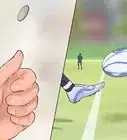wikiHow is a “wiki,” similar to Wikipedia, which means that many of our articles are co-written by multiple authors. To create this article, 127 people, some anonymous, worked to edit and improve it over time.
There are 13 references cited in this article, which can be found at the bottom of the page.
This article has been viewed 959,628 times.
Learn more...
If you've ever wondered about the basics of how to play (or at least follow) American-style football, you're not alone. American football can seem like a bunch of guys repeatedly crashing into each other until you understand some of the basics and start to see the strategy involved.
Steps
Understanding Rules and Terminology
-
1Know the main point of the game. The goal of American football is to score points by carrying the ball from a starting point on a 120-yard long and 53.3-yard wide field into a specially marked 10-yard-deep area at either end of the field called an end zone. Each team uses the end zone in front of them to score while trying to prevent the opposing team from reaching the end zone behind them.[1] Each end zone has a Y-shaped structure called the field goal which is positioned on the end line. The field goals are used to score points with special kicks. [2]
- The end zone that a team is defending is usually referred to as “their” end zone. Thus, a team with 70 yards (64.0 m) to go before it can score a touchdown is 30 yards (27.4 m) from its end zone.
- Teams trade possession of the ball according to strict rules. Whichever team is in possession of the ball is known as the “offense;” the other team is called the “defense.”
-
2Learn the time divisions. Football is divided into four quarters of 15 minutes each, with a break between the second and third periods called “halftime” that is normally 12 minutes long.[3] While the clock is active, the game is divided into even shorter segments called “plays" or "downs."
- A play begins when the ball is moved from the ground into the hands of the players, and ends when either the ball hits the ground, or the person holding the ball is tackled and his knee or elbow touches the ground. When a play is over, an official called a referee, places the ball on the yard marker which corresponds to his or her judgment of the place where the forward progress of the player with the ball was stopped. Each team has 4 downs and within those downs, they have to make ten yards from the line of scrimmage (the starting point). If the team fails to do so within the 4 downs, the offensive team has to hand over the ball to the opposing team. If the offense succeeds in taking the ball 10 yards in the 4 downs they get another 4 downs to move the ball 10 yards. The teams have 30 seconds to get into formation and begin the next play.
- Play time can stop for a few different reasons: If a player runs out of bounds, a penalty is called, a flag is thrown, or a pass is thrown but not caught by anybody (an incomplete pass), the clock will stop while referees sort everything out.
- Penalties are indicated by referees, who throw yellow flags onto the field when they see a violation. This lets everyone on the field know that a penalty has been called. Penalties normally result in the offending team losing between 5-15 yards of field position.[4] There are many penalties, but some of the most common are “offside” (someone was on the wrong side of the line of scrimmage when the ball was snapped), “holding” (a player grabbed another player with his hands, and either player doesn't have the ball, instead of blocking him properly), "false start" (when a player moves before the ball is snapped), "Unsportsmanlike conduct" (when a player does something that doesn't show good sportsmanship, and “clipping” (someone contacted an opposing player other than the ball carrier from behind and below the waist).
Advertisement -
3Learn the flow of the game. American football is made up of two basic structural elements that guide play. These are the kickoff and the downs system.
- The opening kickoff - At the very beginning of the game, the head referee flips a coin and the home team captain calls out which side of the coin will be face up. If correct, that captain may choose to kick off or to receive the opening kickoff or allow the visiting team captain to make that choice. Once the kicking and receiving teams are decided, the team captain who lost the coin toss gets to decide which goal his or her team will defend during the first half. This initial play is called the kickoff, and typically involves a long kick down field from one team to the other, with the team that kicked the ball rushing towards the team receiving the ball in order to prevent them from running the ball a long ways back towards the kicking team's end zone. After halftime, there is a second kickoff by whichever team did not perform the opening kickoff. Throughout the second half, the end zones each team defends is the one opposite the end zone that team defended in the first half.
-
Downs - The word “down” is synonymous with the word “chance” or "plays" in American football. The offense is allowed four downs to move the ball at least 10 yards (9.1 m) towards the end zone. Each play ends in a new down. If the goal of 10 yards (9.1 m) from the first down is achieved before the fourth down is over, the count resets to the first down, commonly noted as “1st and 10” to indicate that the standard 10 yards (9.1 m) are once again required to reset to the first down.[5]
Otherwise, the downs count from one to four. If four downs pass without resetting to the first down, control of the ball passes to the other team.
- This means that a team that moves the ball 10 or more yards on each play will never be on the second down. Every time the ball is moved 10 yards (9.1 m) or more in the proper direction, the next play is a first down with 10 yards (9.1 m) to go.
- The distance required to reset to the first down is cumulative, so running 4 yards (3.7 m) on the first down, 3 yards (2.7 m) on the second, and 3 yards (2.7 m) on the third is enough for the next play to be a first down again.
- If a play ends with the ball behind the line of scrimmage, the difference in yards is added to the total number of yards required for a first down. For example, if the quarterback is tackled 7 yards (6.4 m) behind the line with the ball in his hands, the next play will be noted as “2nd and 17,” meaning that 17 yards (15.5 m) must be covered in the next three plays to reset to a first down.
- Instead of playing the fourth down, the offense can choose to punt the ball, which is a long kick that transfers control of the ball to the other team, but is likely to force them to start farther up the field than they would otherwise have been.
-
4Learn about the composition of a team. Each team is allowed to have eleven players on the field at once. Different team members hold different positions and have different duties on the field. Most competitive teams are actually composed of three separate teams of players, each of which is rotated onto the field to perform one type of task.[6]
- The offensive team includes the following players:
- The quarterback, who throws a pass to a running back, fullback, wide receiver, or tight end, or hands the ball to a runner. The quarterback may also run with the ball.
- The offensive line, composed of the center, two guards, and two tackles, who collectively defend the other players from the defense while the ball is being handed off or passed. The center is directly in front of the quarterback and "snaps" (tosses the ball backwards) the ball to him. The guards are on either of the center's shoulders, and the tackles line up on the guard's shoulders
- Wide receivers, who run over the line of scrimmage and catch the ball if a pass is being thrown.
- The running back, who takes the ball from the quarterback and runs it towards the end zone.
- Tight ends, who help defend the outside edges of the line and can also catch the ball in case of a pass.
- The defensive team comprises the following players:
- Linebackers, who defend against passing plays and also rush through the line and blitz the quarterback.
- The defensive line, who keep the pressure on the offensive line. They can also blitz the quarterback.
- Cornerbacks and safeties, who defend players trying to receive a pass or trying to run the ball down the field past the defensive line. They can also blitz the quarterback.
- The third team is the special team used any time the ball will be kicked. Their job is to allow the person kicking the ball to make a clean kick without being harassed by the other team.[7]
- The offensive team includes the following players:
-
5Keep track of your score. The goal of the game is to score more points than the opposing team. In the case of a tie, an additional 15 minute overtime period is usually played. Scoring is as follows:[8]
- A touchdown is when the football is successfully carried into the proper end zone by a player (or caught by a player standing in the proper end zone), is worth 6 points.
- An extra point, wherein a player kicks the football between the goal posts after his team has scored a touchdown, is worth 1 point. When the touchdown play is followed by a passing or running play into the end zone instead of a kick, the play is called a two point conversion, and is worth 2 points.
- A field goal, is when or where a player kicks the football between the goal posts without having scored a touchdown on the previous play, is worth 3 points. Field goals are commonly seen as last-ditch tactics at the end of close games.
- A safety, wherein a player is so far down the field that he is in his own end zone and is subsequently tackled while holding the ball, is worth 2 points.
Mastering Gameplay Basics
-
1Fight your way forward with running plays. Generally the most common type of play seen in football is the running play. Running plays tend to yield less yardage per play than passing plays but are much less likely to accidentally transfer control of the ball to the other team. They have the added advantage of getting the football out of the quarterback's hands quickly before an aggressive defense can reach his position and cost the team extra yards. If the ball is dropped during a running play, it is called a fumble. A fumbled ball can be picked up by either the other team, or the team that fumbled it to gain or regain control of it.[9]
- The quarterback normally hands the ball off to a teammate (typically a running back) to execute a running play, but he can also choose to run the ball himself. Being able to think quickly and assess the situation as it changes is a vital skill for a quarterback to help him decide when to run the ball on his own.
- Running plays have the benefit of being difficult to see in detail from behind the defensive line. Very often, the offense will try to trick the defense by seeming to hand the ball off to two or even three different runners. When the ruse works, the one runner who actually has the ball can sometimes break past the defense before they know what has happened and run all the way down the field for an easy touchdown.
-
2Pierce the defense with passing plays. Slightly less common than the running play, the passing play is a great way to make up lost yards quickly... if the pass is completed. Short passing plays are often used in combination with running plays as well, to keep the defense on its toes. The great advantage of a passing play is its ability to completely circumvent a tough ground defense.[10] Incomplete passes (wherein nobody catches the ball after it is thrown) stop the clock and end the play.
- The quarterback usually needs more time to throw a pass than is required for a running play, so the offensive line must be exceptionally unyielding while the quarterback scans the field for an open receiver in order to prevent him from being sacked (tackled behind the line of scrimmage while still holding the ball). Once an opening is spotted, the quarterback has to estimate how far to throw the ball so that the receiver will be able to catch it while in motion.
- If a pass is caught by the defense, it is called an interception. A fumble is when the ball comes loose from the offense's hands and the defense gains control of the ball (and becomes the offense). Just as importantly, the play is not over once the ball has been intercepted. The defending player who made the interception can (and often does) turn right around and run the ball back down the field for an exciting touchdown.
-
3Combine passing and running plays. Your offensive team should plan to use a mixture of both running and passing plays in order to keep the defense guessing. Practice a few different formations with your team and get good at running them.[11]
- The quarterback especially should practice throwing the ball accurately, as well as learning to make convincing fake handoffs to the running backs.
- As a rule of thumb, it's safer to start out with a couple of running plays until your team gets a feel for how the defense responds. A defensive team that's great at intercepting the ball might not have much going for it on the ground, or vice versa.
- Adjust your mix accordingly. If you're playing defense, watch player positions carefully and try to anticipate whether the play will be a running play, a short pass, or a long pass so that you can defend against it as effectively as possible. And remember, nothing stops a play of any kind as quickly as sacking the quarterback, so if you see an opening, go for it.
-
4Practice a lot. By far the best way to get better at playing football is to practice regularly. The game uses a special skill set that is not seen very many other places in life, so consistent work is required to improve the way you play.
- Practice with your team if at all possible. Practice holding the ball, catching the ball, and running with it; practice watching the other players so that you can change what you are doing based on what is happening elsewhere on the field.
- Strength and endurance training is very important, too.
- Don't forget to practice strategy and special plays, like field goals, together so that you can go out onto the field and work as an intelligent whole when game day arrives.
-
5Study strategy. This guide only lists the most basic elements of play. Team formations and strategies go far beyond the information presented here. Read up on some of them and think about how your team can use them to gain an advantage on the field.[12]
Community Q&A
-
QuestionShould I try for football if I know how to play but haven't practiced much?
 Community AnswerYes. Try your best!
Community AnswerYes. Try your best! -
QuestionI am an 11-year-old girl and I want to play football so bad but other people think it is crazy. What should I do?
 Community AnswerYou can play! Don't worry about what other people think.
Community AnswerYou can play! Don't worry about what other people think. -
QuestionWhat should I do if I'm a girl and want to sign up for football, but no one thinks I can do it?
 Community AnswerIgnore them. Keep practicing and prove them wrong! If you really like football, then don't let other people keep you from playing.
Community AnswerIgnore them. Keep practicing and prove them wrong! If you really like football, then don't let other people keep you from playing.
Warnings
- Football is a rough sport, so get ready to be hit. If you would prefer not to play full-contact football, consider tap football, where you tap them, or flag football, in which players are considered “tackled” when an opposing player pulls a ribbon or flag of cloth off of them.⧼thumbs_response⧽
- It is normal to get bruised up and worn out while playing football, but if you experience any severe or persistent pain, stop playing and get it checked out by a doctor first.⧼thumbs_response⧽
- It has been proven that playing football is linked to chronic traumatic encephalopathy (CTE), which can lead to dementia, depression, and aggression.⧼thumbs_response⧽
References
- ↑ http://www.rulesofsport.com/sports/american-football.html
- ↑ https://operations.nfl.com/the-rules/2018-nfl-rulebook/
- ↑ https://www.mirror.co.uk/sport/other-sports/american-sports/how-long-nfl-game-american-13626956
- ↑ https://www.dummies.com/sports/football/common-penalties-in-american-football/
- ↑ https://www.ducksters.com/sports/football/football_down.php
- ↑ https://www.dummies.com/sports/football/player-positions-in-american-football/
- ↑ https://www.dummies.com/sports/football/special-teams/the-role-of-special-teams-in-a-football-game/
- ↑ https://www.dummies.com/sports/football/how-football-teams-can-score-points-in-game-play/
- ↑ https://www.dummies.com/sports/football/offense/running-plays-in-football/
About This Article
American football is a popular game played between two teams.Each team has 11 players on the field at a time. In professional games, players will specialize in one position on either offense, defense, or special teams. The goal of the game is to score more points than the other team after 4 quarters of play. Before the game starts, each team is assigned a scoring area, called an endzone. The game begins with a kickoff where the defending team kicks the ball as far as they can towards their endzone. To understand the rules of the game, first you must learn how the down system works. Whenever the offensive team takes the ball, they have 4 turns, called “downs,” to move the ball at least 10 yards by passing or running the ball. So, a play on “second and 6” means that it’s the offensive team’s second turn with the ball, and they have 6 yards to go until they get 10 yards and earn a “first down.” If a team does get a first down, they get a new 10-yard target and a fresh set of downs. If a team makes 4 attempts and does not get 10 yards, the opposing team’s offense takes the ball and starts over on 1st down going the opposite direction from wherever the last play ended. Many teams will choose to punt on fourth down rather than run a standard play if they aren’t close to the first down marker. A punt is where the offense voluntarily gives up possession of the ball by kicking it towards their endzone. A punt is often preferable to “going for it” on a fourth down because it will take the other team longer to get to their side of the field and potentially score. There are three main ways that a team can score in American football, with the highest number of points awarded when a player takes the ball into their endzone for a touchdown. When a player scores a touchdown, their team is awarded 6 points. The offense can then either kick the ball through the uprights for an additional 1 point (called an extra point), or run a normal play and attempt to score again for an additional 2 points (called a two-point conversion). At any time, the offense may also try to kick a field goal by kicking the ball through the uprights. This is common on 4th down when the offensive team is close enough to the uprights to kick it, but too far away from the first down line to risk going for it. If the kicker successfully kicks the ball through the uprights, their team is awarded 3 points. If they miss, the opposing team takes control of the ball wherever the last down took place. Whenever a team scores, the scoring team kicks the ball off from a predetermined point on the field and the team that was on defense takes the field on offense. After 4 quarters of play, the team with the most points is declared the winner. For tips on how to create a great plays, read on!
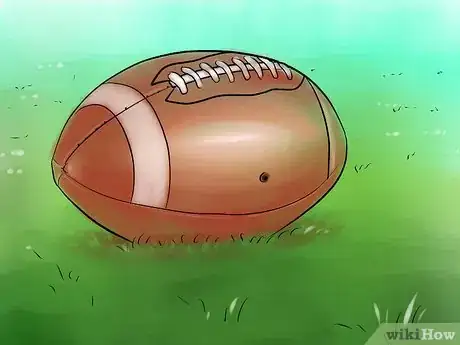

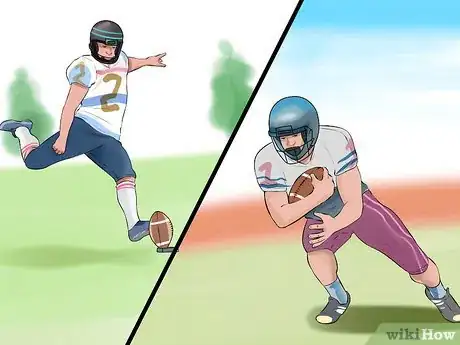

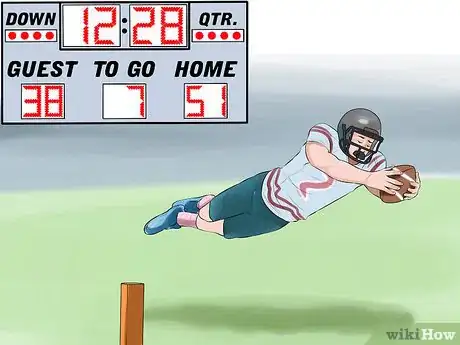




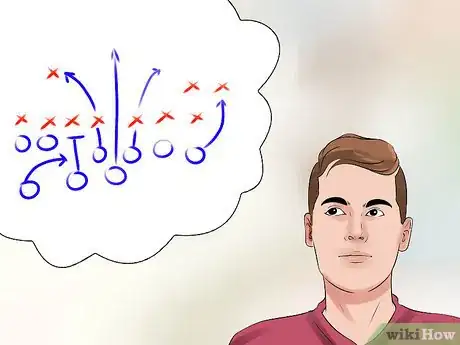
-Step-8.webp)

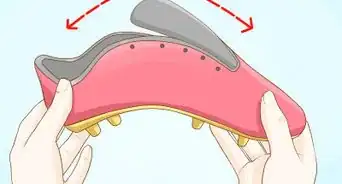
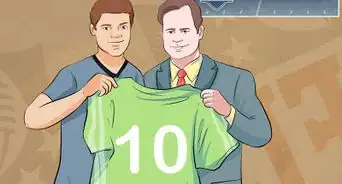
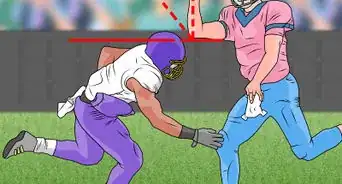



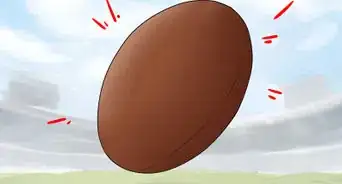










-Step-8.webp)

